Skunk Works (OD-3)
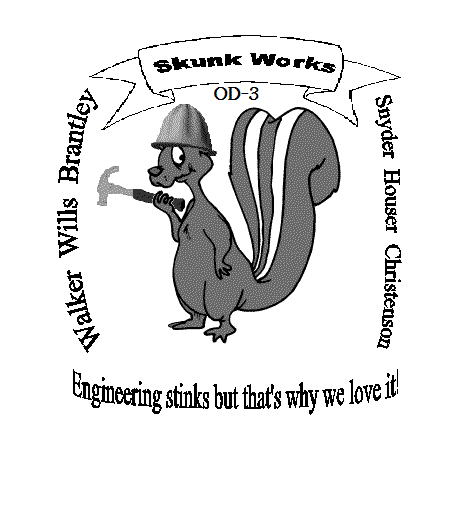
Team Member Webpages:
Evan Snyder
contributed by creating our awesome team name and desigining the logo, as
well as helping to build the bridge, particularly drilling holes in the wood.
He also helped tremendously with the dynamics project because he knew a lot
about projectiles. He did everything from idea generation to building and
calibration. This guy helped so much that I don't even know where to begin.
He managed to spend all of his time working consistently on callibration and
building the bridge, even idea generation. He was the go-to guy, and he knew
just what to do when a problem occurred. He even worked on the trebuche when
no one else showed up.
Kevin Houser contributed
by trying to organize the team's schedule as best as possible, helping sketch
the dimensions, designing the webpage, and helping some with the building
of the bridge, particularly making the most use out of twine. He also helped
with calculation of the timing device, as well as the time the paintball is
in the air and configuring the amount of counterweight needed to reach the
time goal.
John Christenson
contributed by being available and doing whatever we needed him to do. He's
an excellent handy-man, from sawing to putting in pins. He suggested that
we create three separate strings to stop the trebuche when launching the paintball
for the three different distances; rather than marking each distance on one
rope. He had a good eye for watching the painball fly; while the rest of us
could hardly see it in the dark as well as he could.
Karen Walker
contributed by helping to organize the project, creating the report of the
project, offering her home for the team's use, bringing a perfect drill bit
and drill, and putting a lot of effort into finishing the given tasks. She
thinks everything out. She helped a lot with building the trebuche and testing
it, as well as contributing to the idea generation quite a bit. She also spent
a lot of time working on the report to improve since the bridge report.
Preston Wills contributed
by drawing the mechanical desktop drawing, doing a lot of physical labor,
particularly sawing and hammering, creating some good ideas, and helping to
get everyone together to work well as one. Preston had a lot of different
ideas, that's for sure. He came up with some great ideas and helped build
the trebuche, and he spent all day working on the matlab program till it worked
perfectly. He gives good, positive motivation to the team.
Steve Brantley
contributed by doing some major research right off the bat, creating good
ideas for a bridge, and helping to build the bridge. He came into use a whole
lot within the last few days, particularly with solving problems. This guy
worked a lot, particularly a whole lot on the idea generation. He helped build
the timing mechanizm like crazy along with Evan Snyder and Kevin Houser. Although
Steve had several things going on during calibration, he still managed to
show up late to help as much as possible. We appreciate that a lot.

Our Bridge Plan:
We have decided to strictly use pins for the majority of the
joints and hammer them like nails. We began to used a lot of twine for our
joints halfway through the project after coming to the conclusion that the
twine was more supportive than the pins and wood if used correctly. The bridge
is to be constructed of lots of triangles for good stability, two X's underneath
to add extra support, and twine underneath for extra strong support. The twine
is less likely to break than the wood is so the twine can take more force
and help hold the wood together from the bottom. Most of the time building
the bridge was spent outside of class, due to the difficulty of the project
and the lack of time.
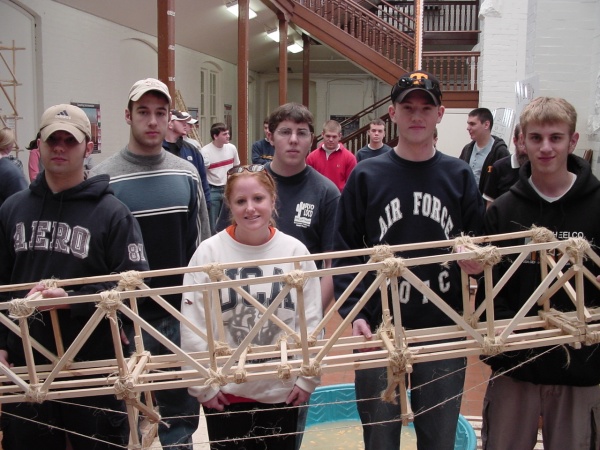
How the Bridge Tested Out:
24 meters of pine wood, 70 meters of twine, and 52 pins were
used to create the bridge. The total price was $53.50 and held 260 lb., but
the pine began to break in between the supports on the bottom on one side.
The entire bridge was perfectly supportive and stable in the middle, but it
began to break in the middle of the beam at the end. When the beam began to
break, one of the vertical supports disconnected itself from a pin, which
caused more beams to break in the same general area. We believe the bridge
would have upheld perfectly under more weight if the quality of the materials
were more trustworthy, and if we had used twine instead of pins for every
support. The twine proved to be very strong because none of the twined joints
disconnected and only one piece of twine broke, which had all of the bridges
weight on it. The bottom piece of twine was supporting 260 lb for several
seconds before it snapped. The overall ratio of the weight held to the dollar
spent was 4.86. We still remain very proud of our bridge, particularly in
the design as well as the majority of the physical labor. With a few modifications
and higher quality material, this bridge would be a very trustworthy design.
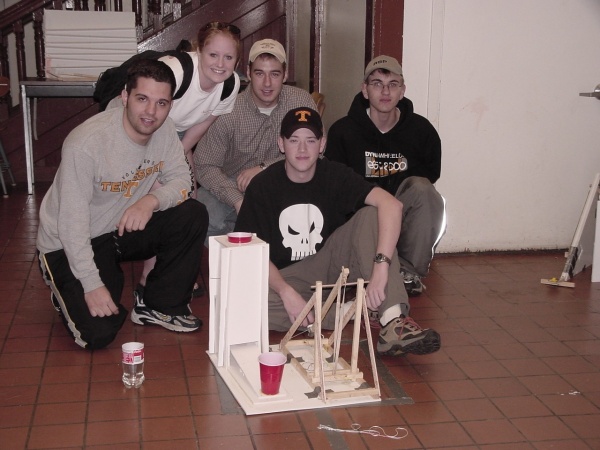
The Dynamics Project
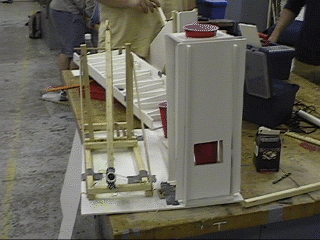
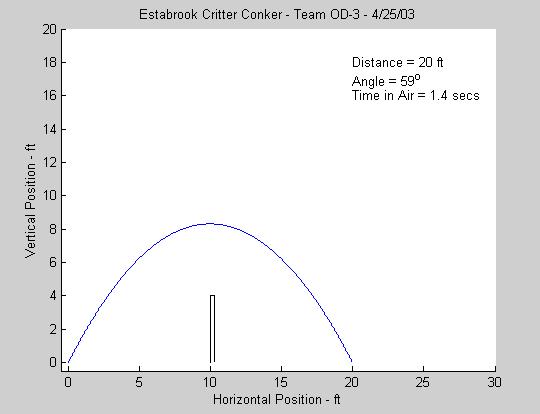
(or right click and click "save
target as...")
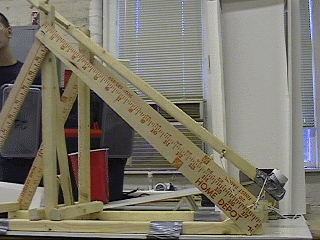
Our Plan
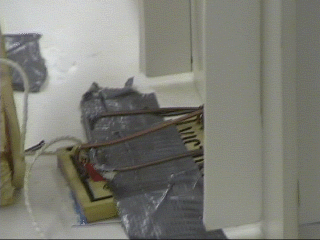
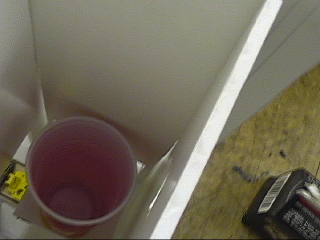
is to create a separate timing device
from the catapault, or a trebuche in our case, so that the distance and the
time of the paintball's launch may be varied. The timing device consists of
three cups. One cup starts on the ground with weight in it on a lever similar
to a see-saw with the other cup raised off the ground with nothing in it.
A cup above the empty cup has a small hole in the bottom and is filled with
water, but it has a plug at the bottom to keep the water from pouring down
at the wrong time.
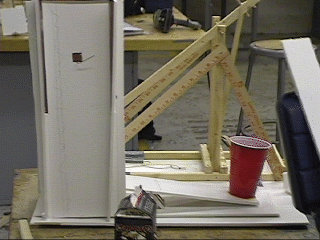
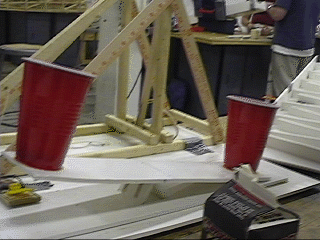
The trebuche has the paintball at one
end near the ground in a basket, a rubberband at the other end to provide
a force to move the trebuche arm, and a rope attached to the base to stop
the arm so that the ball may fly out of the basket. The rope has a slip knot
(not the band) that allows adjustment for the angle of to easily be changed.
The angle of the arm changes the distance the paintball flies.
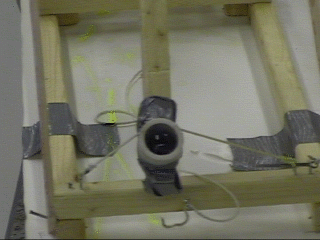
To connect the trebuche to the timing
device we decided to use a pin that can be pulled out of the trebuche by the
mousetrap which is fired off by the empty cup being filled full of water.
When the empty cup is filled with water, it overcomes the weight of the cup
on the other side of the lever and hits the mousetrap. Thus the mousetrap
pulls the pin out of the trebuche and the paintball is launched.

How the Bridge Tested Out
The timing device worked PERFECT! The
trebuche did pretty good too, but not as well as we had expected because we
hit the target precisely the night before testing. I believe the problem with
our trebuche was the disformation of the rubberband. We stretched it out of
proportion and would not reach 30 feet with it. So we replaced it with a new
rubberband. Each launch causes the rubberband to stretch slightly longer than
the time before, thus reducing the spring constant. So in the end, we could
only approximate for what would happen. We still did average/well for just
two runs. We missed the 30 foot target by 5 feet and the 25 foot target by
3.5 feet.
Our timing device was perfected down
to .3 seconds of what we wanted it to be. We used 49 bb's to counterweight
the water when the critter was moving at .55 ft/s, which came out to be 7.9
seconds between pulling the plug on the water and the mousetrap releasing.
It takes approximately 1.5 seconds for our catapault to launch the paintball
25 feet. Our timing was perfect, but we did not calibrate the trebuche well
enough. We used 26 bb's to counterweight the water when the critter was moving
at .8 ft/s, and our timing came out better than when the critter was moving
slower.
We all seem to be very proud of this
project because it seemed to prove worthwhile, and it didn't break like our
bridge. It didn't seem like a waste of time at all, and it was a lot easier
to calculate what we needed to do than we expected at the beginning of the
project. We're all glad to have had the experience of working as a team to
create a complex system of dynamic elements.












